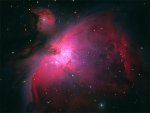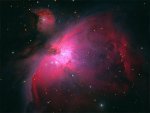The first time you see it, it takes your breath away. Even from well over a thousand light years away the Orion nebula is a majestic sight to behold. As a young boy I studied it with a telescope, imaging it and recording the light of its young stars. They seemed so far away, remote and separated from the turmoils surrounding nearby worlds. This picture I recorded with my telescope while vacationing on a small island back on earth:

Recently I've begun thinking about those distant stars once again. Naturally occurring earth-like worlds are rare jewels for future colonization in a sea of completely inhospitable, toxic, hellish rocks that are laughingly referred to as "terraforming candidates." What if the unthinkable happened to our relatively small, inhabited corner of the galaxy? Where would the survivors go? Refugees looking for a suitable home may not have the resources or time to completely terraform a barren planet whose only redeeming qualities are its mass and location in a circumstellar habitable zone. In order to survive they may need the resources of multiple systems close at hand. The dense stellar cluster within the Orion nebula may serve the needs of humanity in the future, either due to natural expansion or due to a more pressing need brought on by disaster. Even if earth-like and water worlds are relatively rare, there are so many stars within the nebula that there are bound to be at least a handful within reach of each other even with low range frameshift drives. The difficulty is getting there, but once there it may be necessary for future colonists to construct relatively simple low range vessels to go out and mine resources from neighboring systems. The Orion nebula may one day be more than just a stellar nursery, it may serve as a life boat for humanity. Back on ancient earth it was once thought that becoming a multi-planet species was the key to enduring survival. In these turbulent times I think most realize that even a multi-planet species can suffer extinction, particularly if it turns on itself. Having a complete catalog of potential homes in a dense region of space may one day make the difference between survival and extinction.
This will serve as a journal of my travels through the nebula. I will attempt to catalog every earth-like and water world within the nebula. I understand the monumental task I am undertaking, but I believe it may be vitally important to our future as a species. I will post images of every earth-like planet I find, and I will also transmit occasional video logs, particularly if I come across anything unusual in the nebula. Here is my first video log entry:
[video=youtube;zdeHXlZ5TkM]https://www.youtube.com/watch?v=zdeHXlZ5TkM[/video]
Please be advised that due to the distance of the nebula and local conditions, my Cobra Mk III may have trouble transmitting clear audio and video. I will do my best to boost the signal strength when necessary.
*After suffering a complete control system malfunction I am out of commission until I can acquire a replacement joystick and throttle. When I head back out my plan is to go beyond the Orion nebula and explore lesser-known sights around it.

Recently I've begun thinking about those distant stars once again. Naturally occurring earth-like worlds are rare jewels for future colonization in a sea of completely inhospitable, toxic, hellish rocks that are laughingly referred to as "terraforming candidates." What if the unthinkable happened to our relatively small, inhabited corner of the galaxy? Where would the survivors go? Refugees looking for a suitable home may not have the resources or time to completely terraform a barren planet whose only redeeming qualities are its mass and location in a circumstellar habitable zone. In order to survive they may need the resources of multiple systems close at hand. The dense stellar cluster within the Orion nebula may serve the needs of humanity in the future, either due to natural expansion or due to a more pressing need brought on by disaster. Even if earth-like and water worlds are relatively rare, there are so many stars within the nebula that there are bound to be at least a handful within reach of each other even with low range frameshift drives. The difficulty is getting there, but once there it may be necessary for future colonists to construct relatively simple low range vessels to go out and mine resources from neighboring systems. The Orion nebula may one day be more than just a stellar nursery, it may serve as a life boat for humanity. Back on ancient earth it was once thought that becoming a multi-planet species was the key to enduring survival. In these turbulent times I think most realize that even a multi-planet species can suffer extinction, particularly if it turns on itself. Having a complete catalog of potential homes in a dense region of space may one day make the difference between survival and extinction.
This will serve as a journal of my travels through the nebula. I will attempt to catalog every earth-like and water world within the nebula. I understand the monumental task I am undertaking, but I believe it may be vitally important to our future as a species. I will post images of every earth-like planet I find, and I will also transmit occasional video logs, particularly if I come across anything unusual in the nebula. Here is my first video log entry:
[video=youtube;zdeHXlZ5TkM]https://www.youtube.com/watch?v=zdeHXlZ5TkM[/video]
Please be advised that due to the distance of the nebula and local conditions, my Cobra Mk III may have trouble transmitting clear audio and video. I will do my best to boost the signal strength when necessary.
*After suffering a complete control system malfunction I am out of commission until I can acquire a replacement joystick and throttle. When I head back out my plan is to go beyond the Orion nebula and explore lesser-known sights around it.
Attachments
Last edited:

